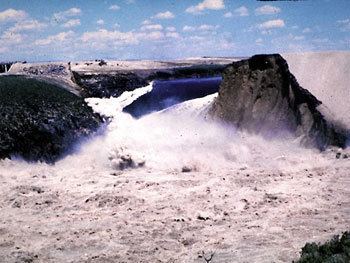 | ||
A dam is a barrier across flowing water that obstructs, directs or slows down the flow, often creating a reservoir, lake or impoundments. Most dams have a section called a spillway or weir over or through which water flows, either intermittently or continuously, and some have hydroelectric power generation systems installed.
Contents
Dams are considered "installations containing dangerous forces" under International Humanitarian Law due to the massive impact of a possible destruction on the civilian population and the environment. Dam failures are comparatively rare, but can cause immense damage and loss of life when they occur. In 1975 the failure of the Banqiao Reservoir Dam and other dams in Henan Province, China caused more casualties than any other dam failure in history. The disaster killed an estimated 171,000 people and 11 million people lost their homes.
Main causes of dam failure
Common causes of dam failure include:
Deliberate dam failure
A notable case of deliberate dam failure (prior to the Humanitarian Law rulings) was the British Royal Air Force Dambusters raid on Germany in World War II (codenamed "Operation Chastise"), in which three German dams were selected to be breached in order to impact on German infrastructure and manufacturing and power capabilities deriving from the Ruhr and Eder rivers. This raid later became the basis for several films.
Other cases include the Chinese bombing of multiple dams during Typhoon Nina (1975) in an attempt to drain them before their reservoirs overflowed. The typhoon produced what is now considered a 1-in-2000 years flood, which few if any of these dams were designed to survive.
